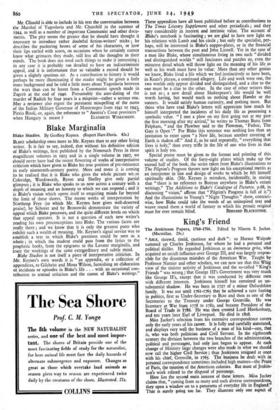Blake Marginalia
Blake Studies. By Geoffrey Keynes. (Rupert Hart-Davis. 42s.) BLAIC.E scholarship owes more to Mr. Keynes than to any other living writer. It is fair to say, indeed, that without his definitive edition of Blake's writings, first published by the Nonesuch Press in three magnificent volumes in 1925 and in a single volume in 1927, we should never have had the recent flowering of works of interpretative criticism which have given to Blake his true position of pre-eminence in early nineteenth-century poetry. More and more it is coming to be realised that it is Blake who gives the whole picture wIr.:re Coleridge, Wordsworth, Byron and Shelley give only partial glimpses ; it is Blake who speaks to us now across a century with a depth of meaning and an honesty to which we can respond ' - and it is Blake's vision which opens itself to enquiring minds far beyond the limit of these shores. The recent works of interpretation by Northrop Frye (to which Mr. Keynes here gives well-deserved praise), by Schorer and by Bronowski demonstrate the variety of appeal which Blake possesses, and the quite different levels on which that appeal operates. It is not a question of each new writer's reading his own preconceptions into Blake. The various facets are really there ; and we know that it is only the greatest poets who exhibit such a wealth of meaning. Mr. Keynes's signal service was to establish a text in which Blake's greatness could be seen as a whole ; in which the student could pass from the lyrics to the prophetic books, from the epigrams to the Lavater marginalia, and trace the workings of the same extriprdinary and subtle mind. Blake Studies is not itself a piece ofinterpretative criticism. In Mr. Keynes's own words it is " an appendix, or a collection of appendices, to Gilchrist and Mona Wilson, furnishing an elaboration of incidents or episodes in Blake's life . . . with an occasional con- tribution to textual criticism and the canon of Blake's writings." These appendices have all been published before as contributions to The Times Literary Supplement and other periodicals ; and they
vary considerably in interest and intrinsic value. The account of Blake's notebook is fascinating ; we are glad to have new light on his relations with Lamb and his circle ; but only the specialist, per- haps, will be interested in Blake's copper-plates, or in the financial transactions between the poet and John Linnell. Yet in the case of a man like Blake, whose simultaneous living in two such " divided and distinguished worlds " still fascinates and puzzles us, even the minutest detail which will throw light on the meaning of his life as well as his work must have its value.' More than any other genius we know, Blake lived a life which we feel instinctively to have been, in Keats's phrase, a continued allegory. Life and work were one, the
two worlds only appear divided and distinguished, and a clue to the one must be a clue to the other. In the case of other writers this is not so ; a new detail about Shakespeare's life would be well worth having, but would teach us nothing about Hamlet or the sonnets. It would satisfy human curiosity, and nothing more. But those who have read Blake's letters will appreciate how much he himself interpreted the incidents of his daily life as possessing a symbolic value. " I met a plow on my first going out at my gate the first morning after my arrival," he writes to Thomas Butts from. Felpham, " and the Plowboy said to the Plowman, Father, The Gate is Open '." For Blake this sentence was nothing less than an invitation to enter upon " a New life, because another covering of Earth is shaken off." And if, as he said repeatedly, " everything that lives is holy," then every trifle in the life of one who lives in that spirit is holy too.
Special praise must be given to the format and printing of this volume of studies. Of the forty-eight plates which make up the second half of the book, the series taken from Blake's illustrations to The Pilgrim's Progress throws new light on his exceptional merits as an interpreter in line and design of works to which he felt himself spiritually akin. (Mr. Keynes is mistaken, incidentally, in stating that " there is no reference to Bunyan anywhere in Blake's extant writings." The Additions to Blake's Catalogue of Pictures, p.68, in discussing " vision," affirms that " Pilgrim's Progress is full of it.") And the illustrations to Young's " Night Thoughts " show, contrari- wise, how Blake could take the words of an uninspired text and weave round them a world of fantasy to which his prosaic original


































 Previous page
Previous page